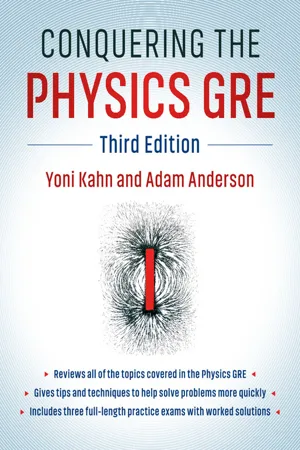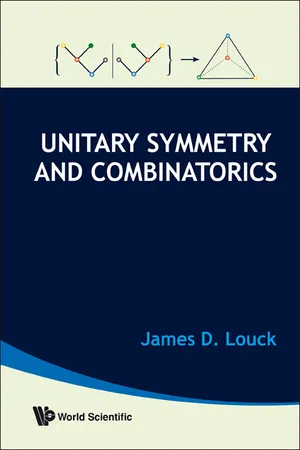Physics
Angular Momentum of One Particle
Angular momentum of one particle is a measure of its rotational motion. It is a vector quantity defined as the cross product of the particle's position vector and its linear momentum. The magnitude of the angular momentum is proportional to the particle's mass, velocity, and the distance from the axis of rotation.
Written by Perlego with AI-assistance
Related key terms
1 of 5
11 Key excerpts on "Angular Momentum of One Particle"
- eBook - PDF
- Robert Resnick, David Halliday, Kenneth S. Krane(Authors)
- 2016(Publication Date)
- Wiley(Publisher)
207 10-1 ANGULAR MOMENTUM OF A PARTICLE We have found linear momentum to be useful in dealing with the translational motion of single particles or of sys- tems of particles, including rigid bodies. For example, lin- ear momentum is conserved in collisions. For a single parti- cle the linear momentum is (Eq. 6-1); for a system of particles it is (Eq. 7-21), in which M is the total system mass and is the velocity of the center of mass. In rotational motion, the analogue of linear momen- tum is called angular momentum, which we define below for the special case of a single particle. Later, we broaden the definition to include systems of particles, and we show that angular momentum is as useful a concept in rotational motion as linear momentum is in translational motion. Consider a particle of mass m and linear momentum at a position relative to the origin O of an inertial refer- ence frame; for convenience (see Fig. 10-1) we have chosen the plane defined by the vectors and to be the xy plane. We define the angular momentum of the particle with re- l B r B p B r B p B v B cm P B M v B cm p B m v B spect to the origin O to be (10-1) As in the case of torque, angular momentum is defined in terms of a vector product or cross product (see Appendix H). Note that we must specify the origin O in order to de- fine the position vector in the definition of angular mo- mentum. Angular momentum is a vector. Its magnitude is given by (10-2) where is the smaller angle between and its direction is perpendicular to the plane formed by and The sense is given by the right-hand rule: swing the fingers of the right hand from the direction of into the direction of through the smaller angle between them; the extended right thumb then points in the direction of (parallel to the z axis in Fig. 10-1). We also can write the magnitude of either as (10-3a) l (r sin )p pr l B l B p B , r B p B . - eBook - PDF
Engineering Dynamics
A Comprehensive Introduction
- N. Jeremy Kasdin, Derek A. Paley(Authors)
- 2011(Publication Date)
- Princeton University Press(Publisher)
This observation gives us a new law. Law 4.1 The law of conservation of angular momentum of a particle states that, when the total moment acting on a particle relative to point O is zero, the inertial angular momentum of the particle relative to O is a constant of the motion. It is important to note that angular momentum can be conserved even when there is a nonzero force acting on a particle, as long as the total moment about O is zero. This is in contrast to linear momentum, where the total force must be zero for the momentum to be a constant. We discuss an important example of this in Section 4.2.4. 4.2.2 Angular Momentum Relative to an Arbitrary Point Our discussion in the previous section is a special case of the more general scenario in which the angular momentum is defined relative to an arbitrary point that may be accelerating in absolute space. LINEAR AND ANGULAR MOMENTUM OF A PARTICLE 123 (a) (b) P r Q/O r P/O I v P/O I v Q/O I B O Q P e 2 e 3 e 1 r P/Q I v P/Q I h P/Q I B O Q e 2 e 3 e 1 Figure 4.7 Angular momentum relative to an arbitrary point. (a) Points P and Q move in the plane spanned by e 1 and e 2 . There is a nonrotating frame B attached to Q . (b) Angular momentum I h P/Q is the vector in the e 3 direction formed by applying the right-hand rule to the cross product r P/Q × m P I v P/Q , where I v P/Q is equal to I v P/O − I v Q/O . Figure 4.7 illustrates the angular momentum of point P relative to an arbitrary point Q moving in the inertial reference frame I . We also introduce a nonrotating but translating frame B fixed to Q . Using Definition 4.2, the angular momentum relative to Q is I h P/Q = r P/Q × m P I v P/Q , (4.14) where I v P/Q = I d dt ( r P/Q ) . 1 We substitute in Eq. (4.14) for both the position and velocity of P relative to Q using the appropriate vector triads from Figure 4.7 to obtain I h P/Q = ( r P/O − r Q/O ) × m P ( I v P/O − I v Q/O ). - Raymond Serway, John Jewett(Authors)
- 2018(Publication Date)
- Cengage Learning EMEA(Publisher)
A particle moving in a straight line such as the skater in Figure 11.3 has angular momentum about any axis displaced from the path of the particle, such as an axis through the pole in Figure 11.3. See the What If? in Example 11.3. Example 11.3 Angular Momentum of a Particle in Uniform Circular Motion A particle moves at constant speed in the xy plane in a circular path of radius r as shown in Figure 11.5. Find the magnitude and direction of its angular momentum relative to an axis through O when its velocity is v S . S O L U T I O N Conceptualize The linear momentum of the parti- cle is always changing in direction (but not in mag- nitude). You might therefore be tempted to conclude that the angular momentum of the particle is always changing. In this situation, however, that is not the case. Let’s see why. Categorize We use the definition of the angular momentum of a particle discussed in this section, so we categorize this exam- ple as a substitution problem. Use Equation 11.14 to evaluate the magnitude of L S : L 5 mvr sin 908 5 mvr This value of L is constant because all three factors on the right are constant. The direction of L S also is constant, even though the direction of p S 5 m v S keeps changing. To verify this statement, apply the right-hand rule to find the direction of L S 5 r S 3 p S 5 m r S 3 v S in Figure 11.5. Your thumb points out of the page, so that is the direction of L S . Hence, we can write the vector expression L S 5 smvrd k ⁄ . If the particle were to move clockwise, L S would point downward and into the page and L S 5 2smvrd k ⁄ . A particle in uniform circular motion has a constant angular momentum about an axis through the center of its path. W H A T I F ? The particle in Figure 11.4 moves in a straight line at constant speed along a path parallel to the linear momentum vector p S . Is the angular momentum of the particle constant in this case? Answer Yes. In Equation 11.14, m and v are constant while r and f vary in time.- eBook - PDF
- R. Douglas Gregory(Author)
- 2006(Publication Date)
- Cambridge University Press(Publisher)
Angular momentum principle about the centre of mass The angular momentum principle in the form (11.12) does not generally apply if A is a moving point. However, the standard form does apply when moments and angular 296 Chapter 11 The angular momentum principle momenta are taken about the centre of mass G, even though G may be accelerating. This follows from the theorem below. The corresponding result for kinetic energy appeared in Chapter 9. Theorem 11.1 Suppose a general system of particles S has total mass M and that its centre of mass G has position vector R and velocity V . Then the angular momentum of S about O can be written in the form L O = R ×( M V ) + L G , (11.13) where L G is the angular momentum of S about G in its motion relative to G. Proof. By definition, L G = N i =1 m i ( r i − R) ×(v i − V ) = N i =1 m i r i ×v i − N i =1 m i r i × V − R × N i =1 m i v i + N i =1 m i R × V = L O − ( M R) × V − R ×( M V ) + M ( R × V ) = L O − R ×( M V ), as required. The two terms on the right of equation (11.13) have a nice physical interpretation. The term R × ( M V ) is the translational contribution to L O while the term L G is the contribution from the motion of S relative to G. If S is a rigid body, then the motion of S relative to G is an angular velocity about some axis through G, and the term L G then represents the rotational contribution to L O . The angular momentum principle for S about O can therefore be written K O = d dt ( M R × V ) + d L G dt = M R × ˙ V + d L G dt . Furthermore, since K O = K G + R × F, it follows that K G = d L G dt + R × M ˙ V − F = d L G dt , on using the linear momentum principle. We therefore obtain: Angular momentum principle about G d L G dt = K G (11.14) 11.4 The angular momentum principle 297 Thus the standard form of the angular momentum principle applies to the motion of S relative to the centre of mass G. - eBook - PDF
- Yoni Kahn, Adam Anderson(Authors)
- 2018(Publication Date)
- Cambridge University Press(Publisher)
We know M, m, V , v, and θ here and we are solving for φ. Thus all we actually need is the second of the two equations, which gives us the result that φ = arcsin − M m sin θ . The minus sign makes good physical sense: if θ is positive, the mass-M ball goes up, giving a negative φ. The ball of mass m goes down, conserving momentum perpendicular to the initial direction. For practice, do a limiting-case analysis for the M and m dependence as well. final state, then set the two equal. The angular momentum of a point particle of linear momentum p is defined by L = r × p, (1.16) where r is the vector from a chosen reference point to the par- ticle. Remember that rotational motion is always defined with respect to a reference point or axis. For an extended body we also have L = I ω, (1.17) where I is the moment of inertia and ω is the angular veloc- ity vector. Conceptually, I plays the same role as the mass m in the definition of linear angular momentum p = mv. Extending the metaphor, the analogue of force F for rotational motion is the torque τ = r × F. (1.18) Classic problems include merry-go-rounds and spinning disks. For instance, if a person jumps onto a spinning disk with a known moment of inertia, how does the rotational velocity change? Just equate L = I ω in the initial and final states. We wrote angular momentum and torque in their vector form for completeness above. Note, however, that the vector form is only really needed for the definitions of L and τ . The analogues of the equations p = mv and F = dp/dt are only used on the GRE in their scalar forms: L = I ω, (1.19) τ = dL dt . (1.20) Problems involving angular momentum can also be con- ceptual, asking for the configuration of momentum, velocity, and acceleration vectors for a system involving rotational motion. The key point to remember is that the angular - eBook - PDF
- James D Louck(Author)
- 2008(Publication Date)
- World Scientific(Publisher)
There are, fortunately, general invariance properties of the Schr¨ odinger equation and its solution state functions for a complex composite phys-ical systems that can be used to classify the quantum states of physical systems into substates available to the system. Our focus here is on the properties of the total angular momentum of a physical system, which is a quantity L that has a vector expression L = L 1 e 1 + L 2 e 2 + L 3 e 3 in the right-handed frame ( e 1 , e 2 , e 3 ) and the expression L = L 1 e 1 + L 2 e 2 + L 3 e 3 in a second rotated right-handed frame ( e 1 , e 2 , e 3 ) . At a given instant of time, necessarily L = L , since these quantities are just redescriptions of the total angular momentum of the system at a given time. The total angular momentum is a conserved quantity; that is, d L /dt = 0 , for all time t, and this property makes the total angular momentum an important quantity for the study of the behavior of complex physical systems. For a system of n point particles, the total angular momentum relative to the origin of the reference frame ( e 1 , e 2 , e 3 ) is obtained by vector addition of that of the individual parti-cles by L = ∑ n i =1 L i , where L i is expressed by the vector cross product L i = x i × p i in terms of the vector position x i = x 1 i e 1 + x 2 i e 2 + x 3 i e 3 and the vector linear momentum p i = p 1 i e 1 + p 2 i e 2 + p 3 i e 3 of the particle labeled i. While angular momentum can be exchanged between interact-ing particles, the total angular momentum remains constant in time for an isolated physical system of n particles. The quantum-mechanical op-erator interpretation of such classical physical quantities is obtained by Schr¨ odinger’s rule p i → − i ∇ i , = h/ 2 π, where h is Planck’s constant. The reference frame vectors ( e 1 , e 2 , e 3 ) remain intact. 1.1. BACKGROUND AND VIEWPOINT 13 The viewpoints of Newtonian physics and quantum physics may be contrasted in many ways. - eBook - PDF
- Gregory J. Gbur(Author)
- 2016(Publication Date)
- CRC Press(Publisher)
This latter aspect was only put under serious scrutiny quite recently [ABSW92], possibly coinciding 111 112 Singular Optics with the growth of singular optics as a field. Since then, there has been extensive research on the subject; see, for instance, the collection edited by Allen, Barnett, and Padgett [ABP03]. The study of optical angular momentum comes with certain concep- tual difficulties. Light is not a rigid or even massive body, leaving signifi- cant ambiguity on how to define the “axis” of rotation for orbital angular momentum (OAM). Furthermore, there is great uncertainty in how to describe the linear momentum of light, and therefore also the angular momentum, while it is traveling in matter, resulting in the 100-year-and- counting Ambraham–Minkowski controversy. Optical angular momentum plays an important role in both practical applications and natural phenomena. In astronomy, it has been observed that complicated light interactions with asymmetric asteroids can change the asteroids’ rotation, in what is known as the YORP effect (see, for instance, [LFP + 07]). In microscopy, the momentum and angular momen- tum of light is now regularly used to trap and rotate small objects in a technique known as optical tweezing, to be discussed in some detail in Chapter 6. In this chapter, we discuss both the momentum and angular momentum of light and conceptual challenges associated with them. We start by return- ing to Maxwell’s equations and deriving the appropriate conservation laws in terms of electric and magnetic fields. 5.1 MOMENTUM AND ANGULAR MOMENTUM IN WAVEFIELDS We begin by considering a region of space that contains time-fluctuating electric and magnetic fields E(r, t ) and B(r, t ). Let us consider the force F(r, t ) on a point particle of charge q that lies within this region, which may be expressed by the Lorentz force law as F(r, t ) = q [E(r, t ) + v × B(r, t )] , (5.1) where v is the velocity of the particle. - eBook - PDF
- William J. Bottega(Author)
- 2014(Publication Date)
- CRC Press(Publisher)
1 │ Preliminaries 45 O F Figure 1.38 Central force motion. or, equivalently, O O H = Δ (1.106) where 2 2 1 1 t t O O t t M dt r F dt ≡ = × (1.107) is the angular impulse about an axis through O , imparted by the force F , or simply the angular impulse about O . The angular impulse is seen to be the impulse of the moment of the applied force about the origin. Conservation of Angular Momentum If the angular impulse about an axis vanishes, then Eqs. (1.105) and (1.106) reduce to the equivalent statements [ ] [ ] 2 1 t t t t r mv r mv = = × = × (1.108) or constant O H r mv = × = (1.109) over the given time interval. When this is so, the angular momentum is said to be conserved about an axis through O . It should be noted that angular momentum may be conserved about an axis through one point and not another. An example of this is when a particle un-dergoes central force motion , where the line of action of the applied force is always directed through the same point (Figure 1.38). 1.5.3 Dynamics of Particle Systems Mechanical systems are typically comprised of many particles. In fact, rigid bodies and deformable bodies may each be considered as an assemblage of a continuous distribution of particles with certain characteristic constraints. In this section we extend the concepts dis-cussed for a single particle to general particle systems. These results may then be abstracted to more complex systems, as needed. We begin by examining the equations of motion for a system of particles. 46 Engineering Vibrations Figure 1.39 System of N particles. Equations of Motion Consider the N particle system shown in Figure 1.39. Let m p ( p = 1, 2, …, N ) represent the mass of particle p , and let p r represent its position vector with respect to a fixed reference frame, as shown. - eBook - PDF
- J.C. Anderson, Keith D. Leaver, Rees D. Rawlings, Patrick S. Leevers(Authors)
- 2004(Publication Date)
- CRC Press(Publisher)
Pictorially we may represent the spinning electron as a fuzzy distribution of mass rotating about its own centre of gravity, rather as a planet spins on its axis while orbiting the Sun. It is difficult to couple this image with that of the wave motion around the nucleus and the reader is not advised to try to do so! However, a spinning wave packet is not too difficult to imagine, although more difficult to draw. Fig. 3.7 The components of angular momentum for the precessing wave, (b) shows that the component meh/2ir can sometimes point in the opposite direction to a magnetic flux density B, when me has a negative value. 48 THE SIMPLEST ATOM: HYDROGEN Fig. 3.8 A pictorial spinning electron (a) and equivalent motion of a 'particle electron' (b). As might be expected, the angular momentum of this spinning motion is quantized and in units of h/27r. To distinguish it from the orbital angular momentum, £h/27r, we call it the spin angular momentum and its magnitude is m s h/27r, where m s is the spin quantum number. Unlike £ and ma, however, m s does not have integral values, but can only take one of two values, + and -. Thus, when a magnetic field is present, the motion can be either clockwise or anticlockwise about the magnetic field direction, the spin angular momentum being equal to ±m s h/27r. Because the vector representing this points along the axis of rotation, the two states are often referred to as 'spin up' and 'spin down' (Fig. 3.8). An explanation of the reason for the non-integral values of m s is beyond the scope of this book. 3.4 Electron clouds In the hydrogen atom Because the shape of the wave function ip is defined by the quantum numbers n, £ and m¿, so too is the probability density distribution for the electron. Thus we may picture an 'electron cloud' that represents the charge distribution in a hydrogen atom using the value of eip 2 as a measure, just as described in Chapter 2. - No longer available |Learn more
Physics for Scientists and Engineers
Foundations and Connections, Extended Version with Modern Physics
- Debora Katz(Author)
- 2016(Publication Date)
- Cengage Learning EMEA(Publisher)
All Rights Reserved. May not be copied, scanned, or duplicated, in whole or in part. WCN 02-300 13-7 Conservation of Angular Momentum 379 All content on this page is © Cengage Learning. CHECK and THINK Because the CD slows down and because its angular velocity is in the negative z direction, the change in its angular momentum is in the positive z direction. In Problem 12.82, you should find that the angular acceleration is also in the positive z direction. Again, it is not a coincidence. 13-7 Conservation of Angular Momentum We found in Chapter 10 that when no net force acts on a system, the system’s trans- lational momentum is conserved, and this principle gave us a way to analyze com- plicated situations such as the decay of a nucleus. In this section, we will learn when and how to apply the principle of conservation of angular momentum. How- ever, to better understand conservation of angular momentum, we consider a system whose angular momentum is changing and derive another expression for Newton’s second law. DERIVATION Another Expression of Newton’s Second Law Another way to express Newton’s second law for a system is dL u tot dt 5 a t u ext (13.27) where t u ext is the total external torque exerted and L u tot is the system’s total angular momentum. Equation 13.27 holds for a single particle, a collection of particles, or an object. Our derivation is made simpler if we consider a single particle moving along a straight path (Fig. 13.28). A net force F u tot acts on the particle so that it speeds up along that path. We will show that for this particle, dL u dt 5 t u tot (13.28) Because the particle’s speed increases, its translational momentum also increases. The particle’s path is along the straight line shown, so r ' does not change, but because the translational momentum p increases, the particle’s angular momentum L around the z axis increases also. - eBook - PDF
Advanced Theoretical Mechanics
A Course of Mathematics for Engineers and Scientists
- Brian H. Chirgwin, Charles Plumpton(Authors)
- 2013(Publication Date)
- Pergamon(Publisher)
CHAPTER III THE DYNAMICS OF A PARTICLE 3:1 General principles The motion of a particle is governed by the law of motion ml = F. Here m is the mass (assumed constant) of the particle, f its acceleration, and F the resultant force upon it. The forces which constitute this resul-tant are the applied forces such as gravity, electromagnetic forces, or forces of constraint arising from contact with a surface, rough or smooth, the tension of a string, the action of a rod or other body to which the particle is attached or on which it slides. When the particle is con-strained its degrees of freedom are reduced to two or one. The method by which we investigate any particular motion is deter-mined by the circumstances of the problem, but there are some general results which apply to many cases. 1. Conservation of linear momentum When there is a fixed direction ê in which the resolute of F is zero, then the resolute of the linear momentum, mv, of the particle in this direc-tion is constant, -r ( m v . ê) = me .^r— = me . f = ê . F = 0. at at . ê = constant. (3.1) 2. Conservation of angular momentum When we considered the motion of a particle under a central force, in Vol. Ill § 6:3, we introduced a vector h = r x mr, the vector h being the angular momentum of the particle about the origin of vectors. In the relations d h d , -7— = m -rr-(r x r) .= r x mf = r x F. at at §3:1] THE DYNAMICS OF A PABTICLE 83 the last member is the vector moment ( ) of the resultant F about the origin. If there is a fixed direction ê in which ( ) has no resolute, i.e., the moment of F about an axis in this direction is zero, then the resolute of h in this direction is constant for -!-(ê.h)=ê.4^- = ê . r x F = ê. v(0) = 0. at at .'. ê . h = constant. (3.2) It is important that the direction ê in (3.1) and (3.2) does not alter with time.
Index pages curate the most relevant extracts from our library of academic textbooks. They’ve been created using an in-house natural language model (NLM), each adding context and meaning to key research topics.










